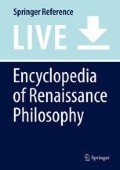Abstract
Rarefactions and condensations, in their simplest form, are those phenomena in which material substances vary in their densities, becoming more fine or tenuous on the one hand or coarser or thicker on the other. Although they might seem unproblematic concepts to modern readers, in fact they have a complex history and even have been seen as fundamental aspects of nature. For a number of thinkers, the phenomena of rarefactions and condensations seemed to suggest, inescapably, that matter must have inbuilt principles of activity. Essentially, this boils down to a belief that matter can determine its own dimensions in some way – either by spreading itself out, or contracting itself inwards, or, in the case of corpuscular theories, by moving its constituent particles closer together or further apart. And this kind of self-determination or self-movement was, for these thinkers, either occult or fundamental and unexplained. It is a sign of the complexity of the issues arising from condensation and rarefaction that alternative, non-occult, attempts to explain these phenomena never achieved full consensus. The most influential account was eventually provided by Isaac Newton by supposing attractive and repulsive forces capable of acting at a distance between atomic particles. But even this was superseded by the non-occult kinetic theory of gases in the late nineteenth century.
References
Fisher, Saul. 2005. Pierre Gassendi’s Philosophy and Science: Atomism for Empiricists. Leiden: Brill.
Grellard, Christophe. 2008. Nicholas of Autrecourt’s atomistic physics. In Atomism in late medieval philosophy and theology, ed. C. Grellard, A. Robert, 107–126. Leiden: Brill.
Henry, John. 1986. Occult qualities and the experimental philosophy: Active principles in Pre-Newtonian matter theory. History of Science 24 (4): 335–381.
Henry, John. 2011. Gravity and De gravitatione: The development of Newton’s ideas on action at a distance. Studies in History and Philosophy of Science 42: 11–27.
Kirk, G.S. 1983. In The presocratic philosophers: A critical history with a selection of texts, ed. G.S. Kirk, J.E. Raven, and M. Schofield, 2nd ed. Cambridge: Cambridge University Press.
Manzo, Silvia. 2016. From Attractio and Impulsus to motion of liberty: Rarefaction and condensation, nature and violence, in Cardano, Francis Bacon, Glisson and Hale. In Early modern philosophers and the renaissance legacy, ed. C. Muratori and G. Paganini, 99–117. Dordrecht: Springer.
Michael, Emily. 2008. John Wyclif’s atomism. In Atomism in late medieval philosophy and theology, ed. C. Grellard, A. Robert, 183–220. Leiden: Brill.
Osler, Margaret J. 1994. Divine will and the mechanical philosophy: Gassendi and Descartes on contingency and necessity in the created world. Cambridge: Cambridge University Press.
Palmerino, Carla Rita. 2011. The isomorphism of space, time and matter in seventeenth-century natural philosophy. Early Science and Medicine 16: 296–330.
Robert, Aurélien. 2008. William Crathorn’s mereotopological atomism. In Atomism in late medieval philosophy and theology, ed. C. Grellard, A. Robert, 127–162. Leiden: Brill.
Schaffer, Simon. 1988. Wallifaction: Thomas Hobbes on school divinity and experimental pneumatics. Studies in History and Philosophy of Science 19: 275–298.
Author information
Authors and Affiliations
Corresponding author
Editor information
Editors and Affiliations
Section Editor information
Rights and permissions
Copyright information
© 2018 Springer International Publishing AG
About this entry
Cite this entry
Wang, X. (2018). Rarefaction and Condensation. In: Sgarbi, M. (eds) Encyclopedia of Renaissance Philosophy. Springer, Cham. https://doi.org/10.1007/978-3-319-02848-4_1173-1
Download citation
DOI: https://doi.org/10.1007/978-3-319-02848-4_1173-1
Received:
Accepted:
Published:
Publisher Name: Springer, Cham
Print ISBN: 978-3-319-02848-4
Online ISBN: 978-3-319-02848-4
eBook Packages: Springer Reference Religion and PhilosophyReference Module Humanities and Social SciencesReference Module Humanities

